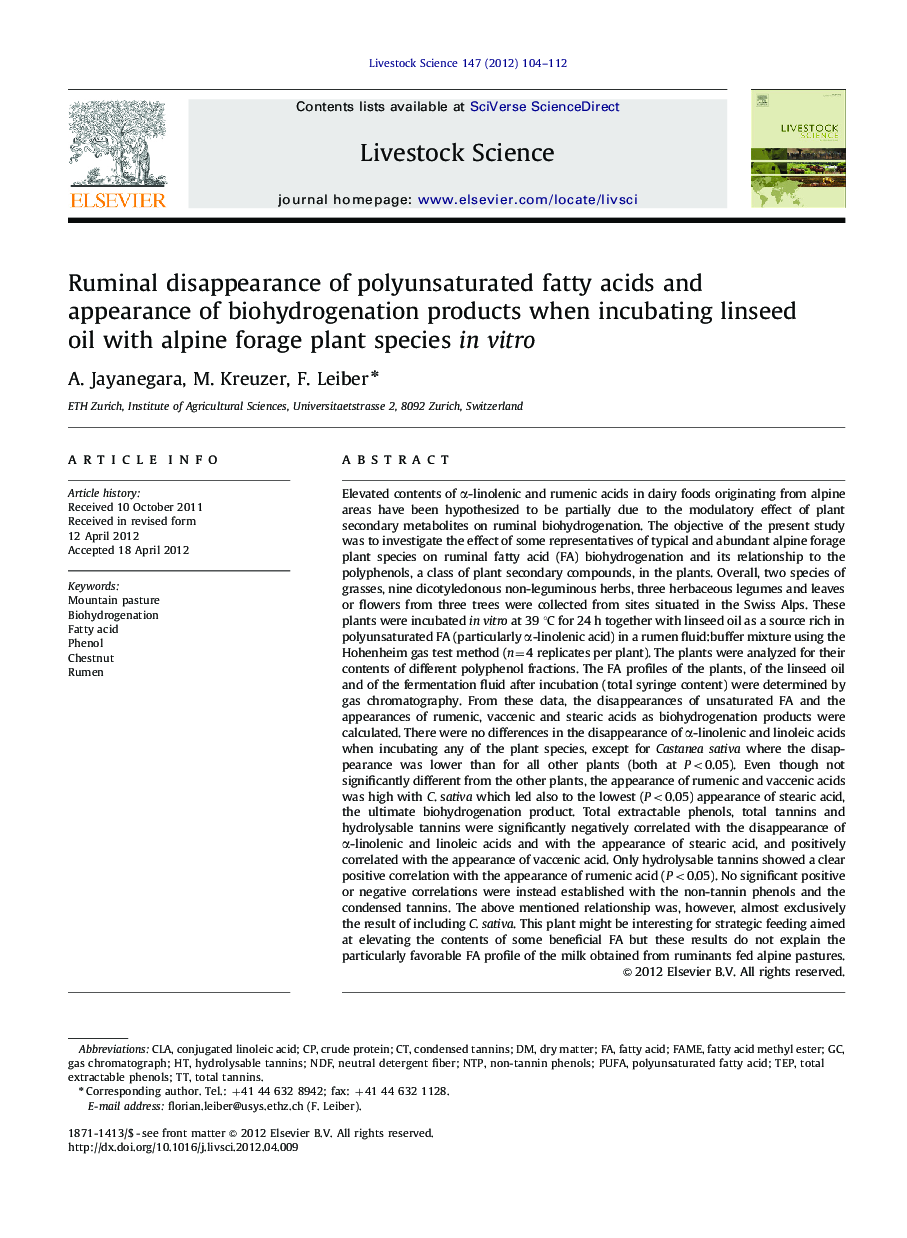| کد مقاله | کد نشریه | سال انتشار | مقاله انگلیسی | نسخه تمام متن |
|---|---|---|---|---|
| 5790539 | 1553985 | 2012 | 9 صفحه PDF | دانلود رایگان |
عنوان انگلیسی مقاله ISI
Ruminal disappearance of polyunsaturated fatty acids and appearance of biohydrogenation products when incubating linseed oil with alpine forage plant species in vitro
دانلود مقاله + سفارش ترجمه
دانلود مقاله ISI انگلیسی
رایگان برای ایرانیان
کلمات کلیدی
total extractable phenolsNDFTEPCLANTPconjugated linoleic acid - اسید لینولئیک کونژوگهFatty acid - اسید چربPolyunsaturated fatty acid - اسید چرب غیر اشباعPUFA - اسید چرب چند غیراشباعbiohydrogenation - بیو هیدروژنCondensed tannins - تانن های متراکم یا تانن های فشردهHydrolysable tannins - تانن های هیدرولیز شدهRumen - شکمبه، سیرابیChestnut - فندقPhenol - فنل neutral detergent fiber - فیبر مواد شوینده خنثیdry matter - ماده خشکFatty acid methyl ester - متیل استر اسید چربFAME یا fatty acid methyl esters - متیل استرهای اسید چربcrude protein - پروتئین خامgas chromatograph - کروماتوگرافی گازMountain pasture - کوهستان کوهستانی
موضوعات مرتبط
علوم زیستی و بیوفناوری
علوم کشاورزی و بیولوژیک
علوم دامی و جانورشناسی
پیش نمایش صفحه اول مقاله

چکیده انگلیسی
Elevated contents of α-linolenic and rumenic acids in dairy foods originating from alpine areas have been hypothesized to be partially due to the modulatory effect of plant secondary metabolites on ruminal biohydrogenation. The objective of the present study was to investigate the effect of some representatives of typical and abundant alpine forage plant species on ruminal fatty acid (FA) biohydrogenation and its relationship to the polyphenols, a class of plant secondary compounds, in the plants. Overall, two species of grasses, nine dicotyledonous non-leguminous herbs, three herbaceous legumes and leaves or flowers from three trees were collected from sites situated in the Swiss Alps. These plants were incubated in vitro at 39 °C for 24 h together with linseed oil as a source rich in polyunsaturated FA (particularly α-linolenic acid) in a rumen fluid:buffer mixture using the Hohenheim gas test method (n=4 replicates per plant). The plants were analyzed for their contents of different polyphenol fractions. The FA profiles of the plants, of the linseed oil and of the fermentation fluid after incubation (total syringe content) were determined by gas chromatography. From these data, the disappearances of unsaturated FA and the appearances of rumenic, vaccenic and stearic acids as biohydrogenation products were calculated. There were no differences in the disappearance of α-linolenic and linoleic acids when incubating any of the plant species, except for Castanea sativa where the disappearance was lower than for all other plants (both at P<0.05). Even though not significantly different from the other plants, the appearance of rumenic and vaccenic acids was high with C. sativa which led also to the lowest (P<0.05) appearance of stearic acid, the ultimate biohydrogenation product. Total extractable phenols, total tannins and hydrolysable tannins were significantly negatively correlated with the disappearance of α-linolenic and linoleic acids and with the appearance of stearic acid, and positively correlated with the appearance of vaccenic acid. Only hydrolysable tannins showed a clear positive correlation with the appearance of rumenic acid (P<0.05). No significant positive or negative correlations were instead established with the non-tannin phenols and the condensed tannins. The above mentioned relationship was, however, almost exclusively the result of including C. sativa. This plant might be interesting for strategic feeding aimed at elevating the contents of some beneficial FA but these results do not explain the particularly favorable FA profile of the milk obtained from ruminants fed alpine pastures.
ناشر
Database: Elsevier - ScienceDirect (ساینس دایرکت)
Journal: Livestock Science - Volume 147, Issues 1â3, August 2012, Pages 104-112
Journal: Livestock Science - Volume 147, Issues 1â3, August 2012, Pages 104-112
نویسندگان
A. Jayanegara, M. Kreuzer, F. Leiber,